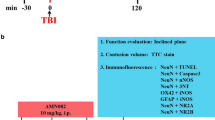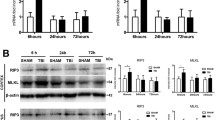Abstract
Activation of muscarinic acetylcholine (ACh) receptors contributes to the pathophysiological consequences of moderate experimental traumatic brain injury (TBI). Hypothermia (30°C) provides protection in experimental TBI. We measured ACh levels in CSF and plasma 5 min after moderate fluid percussion TBI under normothermic or hypothermic conditions, because ACh in the CSF has been correlated with the severity of behavioral deficits after TBI. Three groups were examined: TBI with hypothermic brain (30°C), TBI with normothermic brain (37°C), or sham TBI with normothermic brain (37°C). ACh concentrations in CSF were significantly higher in 37°C TBI rats, but not in 30°C TBI rats compared to shams. ACh concentratons in plasma did not differ between groups. These results suggest that a contributing factor to the neuroprotective effects of moderate hypothermia in TBI may be related to the reduction of excessive ACh levels in the central nervous system following injury.
Similar content being viewed by others
References
Boksa P., Mykita S., and Collier B. (1988) Arachidonic acid inhibits choline uptake and depletes acetylcholine in rat cerebral cortical synaptosomes.J. Neurochem. 50, 1309–1318.
Busto R., Dietrich W., Globus M. Y. T., Valdes I., Scheinberg P., and Ginsberg M. D. (1987) Small differences in intraischemic brain temperature critically determine the extent of ischemic neuronal injury.J. Cereb. Blood Flow Metab. 7, 729–738.
Busto R., Globus M. Y. T., Dietrich W. D., Martinez E., Valdes I., and Ginsberg M. D. (1989) Effect of mild hypothermia on ischemia-induced release of neurotransmitters and free fatty acids in rat brain.Stroke 20, 904–910.
Chou C-L., Lyeth B. G., Jenkins L. W., Hayes R. L., and Povlishock J. T. (1991) Regional cerebral blood flow changes after traumatic brain injury in the rat.Soc. Neurosci. Abstracts. 17, 722.
Clifton G. L., Taft W. C., Blair R. E., Choi S. C., and DeLorenzo R. J. (1989) Conditions for pharmacologic evaluation in the gerbil model of forebrain ischemiaStroke 20, 1545–1552.
Clifton G. L., Jiang J. Y., Lyeth B. G., Jenkins L. W., Hamm R. J., and Hayes R. L. (1991) Marked protection by moderate hypothermia after experimental traumatic brain injury.J. Cereb. Blood Flow Metab. 11, 114–121.
Delahunty T. M., Jenkins L. W., Lyeth B. G., Phillips L. L., Hamm R. J., and Franson R. (1992) Mild traumatic brain injury enhances muscarinic receptor-linked inositol phosphate production in rat hippocampus.Brain Res. 594, 307–310.
Dixon C. E., Lyeth B. G., Povlishock J. T., Findling R. L., Hamm R. J., Marmarou A., Young H. F., and Hayes R. L. (1987) A fluid percussion model of experimental brain injury in the rat.J. Neurosurg. 67, 110–119.
Ellis E. F., Chao J., and Heizer M. L. (1989) Brain kininogen following experimental brain injury: evidence for a secondary event.J. Neurosurg. 71, 437–442.
Enters E. K., Pascua, J. R., McDowell, K. P., Kapasi, M. Z., Povlishock, J. T., and Robinson, S. E. (1992) Blockade of acute hypertensive response does not prevent changes in behavior or in CSF acetylcholine (CSF) content following traumatic brain injury (TBI).Brain Res. 576, 271–276.
Faden A. I., Demediuk P., Panter S. S., and Vink R. (1989) The role of excitatory amino acid and NMDA receptors in traumatic brain injury.Science 244, 798–800.
Gorman L. K., Fu K., Hovda D. A., Becker D. P., and Katayama Y. (1989) Analysis of acetylcholine release following concussive brain injury in the rat.J. Neurotrauma 6, 203.
Haber B. and Grossman R. G. (1980) Acetylcholine metabolism in intracranial and lumbar cerebrospinal fluid and in blood, inNeurobiology and Cerebrospinal Fluid (Wood, J. H., ed.), pp. 345–350, Plenum, New York.
Hayes R. L., Jenkins L. W., Lyeth B. G., Balster R. L., Robinson S. E., Miller L. P., Clifton G. L., and Young H. F. (1988) Pretreatment with phencyclidine, anN-methyl-d-aspartate receptor antagonist, attenuates long-term behavorial deficits in the rat produced by traumatic brain injury.J. Neurotrauma 5, 287–302.
Jiang J. Y., Lyeth B. G., Clifton G. L., Jenkins L. W., Hamm R. J., and Hayes R. L. (1991) Relationship between body and brain temperature in traumatically brain injured rodents.J. Neurosurg. 74, 492–496.
Jiang J. Y., Lyeth B. G., Kapasi M., Jenkins L. W., and Povlishock J. (1992) Moderate hypothermia reduces blood-brain barrier disruption following traumatic brain injury in the rat.Acta Neuropathol. 84, 495–500.
Jope R. S., and Gu X. (1991) Seizures increase acetylcholine and choline concentrations in rat brain regions.Neurochem. Res. 16, 1219–1226.
Kakihana M., Yamazaki N., and Nagaoka A. (1989) Effects of idebenone on the levels of acetylcholine, choline, free fatty acids, and metabolites in the brains of rats with cerebral ischemia.Arch Gerontol. Geriatr. 9, 247–256.
Katayama Y., Becker D. P., Tamura T., and Hovda D. A. (1990) Massive increases in extracellular potassium and the indiscriminate release of glutamate following concussive brain injury.J. Neurosug. 73, 884–900.
Löffelholz K. (1989) Receptor regulation of choline phospholipid hydrolysis: A novel source of diacylglycerol and phosphatidic acid.Biochem. Pharmacol. 38 1543–1549.
Lyeth, B. G., Dixon C. E., Hamm R. J., Jenkins L. W., Young H. F., Stonnington H. H., and Hayes R. L. (1988a) Effects of anticholinergic treatment on transient behavorial suppression and physiological responses following concussive brain injury to the rat.Brain Res. 448, 88–97.
Lyeth B. G., Dixon C. E., Jenkins L. W., Hamm R. J., Alberico A., Young H. F., Stonnington H. H., and Hayes R. L. (1988b) Effects of scopolamine treatment on long-term behavorial deficits following concussive brain injury to the rat.Brain Res. 452, 39–48.
Lyeth B. G., Ray M., Hamm R. J., Schnabel J., Saady J. J., Poklis A., Jenkins L. W., Gudeman S. K., and Hayes R. L. (1992) Post-injury scopolamine administration in experimental traumatic brain injury.Brain Res. 569, 281–286.
Macedo T. M. and Gomez M. V. (1983) the effect of scorpion venom, tityustoxin, on high-affinity choline uptake in rat brain cortical slices.Neuropharmacology 22 233–237.
McIntosh, T. K., Vink R., Soares H., Hayes R. L., and Simon R. (1989) Effects ofN-methyl-d-aspartate receptor blocker MK-801 on neurologic function after experimental brain injury.J. Neurotrauma 6, 247–259.
Povlishock J. T. and Lyeth B. G. (1989) Traumatically induced blood-brain barrier disruption: A conduit for the passage of circulating excitatory neurotransmitters.Soc. Neurosci. Abstracts 15, 1113.
Robinson S. E., Rice M. A., and Hambrecht K. L. (1986) Effect of intrastriatal injection of diisopropylfluorophosphate on acetylcholine, dopamine, and serotonin metabolism.J. Neurochem. 46, 1632–1638.
Robinson S. E., Martin R. M., Davis T. R., Gyenes C. A., Ryland J. E., and Enters E. K. (1990a) The effect of acetylcholine depletion on behavior following traumatic brain injury.Brain Res. 509, 41–46.
Robinson S. E., Fox S. D., Posner M. G., Martin R. M., Davis T. R., Guo H., and Enters E. K. (1990b) The effect of M1 muscarinic blockade on behavior following traumatic brain injury in the rat.Brain Res. 511, 141–148.
Robinson S. E., Borrelli G. S., Ang J. L., Pascua J. R., McDowell K. P., and Enters E. K. (1991) Carbachol-stimulated inositol phosphate (IP) production following traumatic brain injury (TBI).Soc. Neurosci. Abstracts 17, 721.
Sachs E. Jr. (1957) Acetylcholine and serotonin in the spinal fluid.J. Neurosurg. 14, 22–27.
Scremin O. U and Jenden D. J. (1989) Effects of middle cerebral artery occlusion on cerebral cortex choline and acetylcholine in rats.Stroke 20, 1524–1530.
Tower D. B. and McEachern D. (1949) Acetylcholine and neuronal activity: I. Cholinesterase patterns and acetylcholine in the cerebrospinal fluids of patients with craniocerebral trauma.Can. J. Res. 27, 105–119.
Yamamura H. I. and Snyder S. H. (1973) High affinity transport of choline into synaptosomes of rat brain.J. Neurochem. 21, 1355–1374.
Author information
Authors and Affiliations
Rights and permissions
About this article
Cite this article
Lyeth, B.G., Jiang, J.Y., Robinson, S.E. et al. Hypothermia blunts acetylcholine increase in CSF of traumatically brain injured rats. Molecular and Chemical Neuropathology 18, 247–256 (1993). https://doi.org/10.1007/BF03160117
Received:
Accepted:
Issue Date:
DOI: https://doi.org/10.1007/BF03160117




